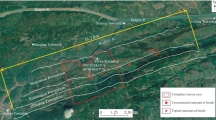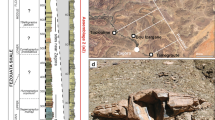Abstract
A new Chengjiang-type fossil assemblage is reported herein from the lower part of the Hongjingshao Formation at Xiazhuang village of Chenggong, Kunming, Yunnan. The fossil assemblage, named as Xiazhuang fossil assemblage, yields predominantly soft-bodied fossils, including arthropods, brachiopods, priapulids, lobopods and some problematic taxa, with arthropods being the most dominant group. Preservation and composition of the fossil assemblage are very similar to the typical Chengjiang biota, which is preserved in the middle Yu’anshan Formation in the large area of eastern Yunnan. The associated trilobites demonstrate that the soft-bodied fossil assemblage belongs to the late Qiongzhusian in age (Stage 3, Cambrian), suggesting that the Hongjingshao Formation is probably a diachronous lithostratigraphic unit ranging from the upper Qiongzhusian to the lower Canglangpuan stages in eastern Yunnan. The fossil assemblage from the Xiazhuang area fills up the missing link between the typical older Chengjiang biota and the younger Malong and Guanshan biotas, making eastern Yunnan a unique area in the world to reveal the early evolutionary history of animals and palaeocommunity dynamics during the “Cambrian explosion”.



Similar content being viewed by others
References
Hendricks JR, Lieberman BS, Stigall AL (2008) Using GIS to study palaeobiogeographic and macroevolutionary patterns in soft-bodied Cambrian arthropods. Palaeogeogr Palaeoclimatol Palaeoecol 264:163–175
Chen JY (2012) Evolutionary scenario of the early history of the animal kingdom: evidence from Precambrian (Ediacaran) Weng’an and early Cambrian Maotianshan biotas, China. In: Talent JA (ed) Earth and life: global biodiversity, extinction intervals and biogeographic perturbations through time. Springer, Heidelberg, pp 239–379
Erwin DH, Valentine JW (2013) The Cambrian explosion: the construction of animal biodiversity. Roberts and Company Publishers, Greenwood Village
Shu DG, Conway MS, Zhang ZF et al (2010) The earliest history of the deuterostomes, the importance of the Chengjiang Fossil-Lagerstätte. Proc R Soc B 277:165–174
Zhu MY (2010) The origin and Cambrian explosion of animals: fossil evidences from China. Acta Palaeontol Sin 49:269–287 (in Chinese)
Hou XG, Aldridge R, Bergström J et al (2004) The Cambrian fossils of Chengjiang, China: the flowering of early animal life. Blackwell, Oxford
Hu SX, Zhu MY, Steiner M et al (2010) Biodiversity and taphonomy of the early Cambrian Guanshan biota, eastern Yunnan. Sci China Earth Sci 53:1765–1773
Luo HL, Li Y, Hu SX et al (2008) Early Cambrian Malong fauna and Guanshan fauna from eastern Yunnan, China. Kunming. Yunnan Science and Technology Press, Kunming (in Chinese)
Steiner M, Zhu MY, Zhao YL et al (2005) Lower Cambrian Burgess Shale-type fossil associations of south China. Palaeogeogr Palaeoclimatol Palaeoecol 220:129–152
Zhao YL, Zhu MY, Babcock LE et al (2011) The Kaili biota: marine organisms from 508 million years ago. Guizhou Science and Technology Press, Guiyang (in Chinese)
Zhang XL, Hua H (2005) Soft-bodied fossils from the Shipai Formation, lower Cambrian of the Three Gorge area, South China. Geol Mag 142:699–709
Zhang XL, Liu W, Zhao YL (2008) Cambrian Burgess Shale-type Lagerstätten in south China: distribution and significance. Gondwana Res 14:255–262
Chen JY, Zhou GQ, Edgecombe GD et al (1995) Head segmentation in early Cambrian Fuxianhuia: implications for arthropod evolution. Science 268:1339–1343
Shu DG, Luo HL, Conway Morris S et al (1999) Lower Cambrian vertebrates from south China. Nature 402:42–46
Chen JY, Dzik J, Edgecombe GD et al (1995) A possible early Cambrian chordate. Nature 377:720–722
Zhang XL, Shu DG, Li Y, et al (2001) New sites of Chengjiang fossils: crucial windows on the Cambrian explosion. J Geol Soc 158:211–218
Luo HL, Zhang SS (1986) Early Cambrian vermes and trace fossils from Jinning-Anning region, Yunnan. Acta Palaeontol Sin 25:307–313 (in Chinese)
Luo HL (1994) On the biographical division of Cambrian in east Yunnan. Yunnan Geol 13:233–239 (in Chinese)
Luo HL, Jiang ZW, Tang LD (1994) Stratotype section for Lower Cambrian stages in China. Yunnan Science and Technology Press, Kunming (in Chinese)
Yang J, Ortega-Hernández J, Butterfield NJ et al (2013) Specialized appendages in fuxianhuiids and the head organization of early euarthropods. Nature 494:468–471
Zhu MY, Babcock LE, Peng SC (2006) Advances in Cambrian stratigraphy and paleontology: integrating correlation techniques, paleobiology, taphonomy and paleoenvironmental reconstruction. Palaeoworld 15:217–222
Steiner M, Zhu MY, Weber B et al (2001) The Lower Cambrian of eastern Yunnan: trilobite-based biostratigraphy and related faunas. Acta Palaeontol Sin 40:63–79
Zhu MY, Li GX, Zhang JM et al (2001) Early Cambrian stratigraphy of east Yunnan, southwestern China: a synthesis. Acta Palaeontol Sin 40:4–39
Zhang WT, Lu YH, Zhu ZL et al (1980) Cambrian trilobites faunas of southwestern China. Science Press, Beijing (in Chinese)
Mansuy H (1912) Étude géologique du Yun-Nan oriental, Pt. 2. Paléontologie. Mémo du Servi Géol de l’Indochine 1:1–146
Dai T, Zhang XL (2008) Ontogeny of the trilobite Yunnanocephalus yunnanensis from the Chengjiang Lagerstätte, lower Cambrian, southwest China. Alcheringa 32:465–468
Zhang WT (1966) On the classification of Redlichiacea, with description of new Families and new Genera. Acta Palaeontol Sin 14:135–178 (in Chinese)
Budd GE (2002) A palaeontological solution to the arthropod head problem. Nature 417:271–275
Fu DJ, Zhang XL (2011) A new arthropod Jugatacaris agilis n. gen. n. sp. from the early Cambrian Chengjiang biota, south China. J Paleontol 85:567–586
Hou XG (1999) New rare bivalved arthropods from the Lower Cambrian Chengjiang fauna, Yunnan, China. J Paleontol 73:102–116
Hou XG (1987) Early Cambrian large bivalved arthropods from Chengjiang, eastern Yunnan. Acta Palaeontol Sin 26:286–298 (in Chinese)
Hou XG, Bergström J (1998) Three additional arthropods from the Early Cambrian Chengjiang fauna, Yunnan, southwest China. Acta Palaeontol Sin 37:395–401
Zhang ZF, Shu DG, Emig C et al (2007) Rhynchonelliformean brachiopods with soft-tissue preservation from the early Cambrian Chengjiang Lagerstätte of South China. Palaeontology 50:1391–1402
Luo HL, Hu SX, Chen LZ et al (1999) Early Cambrian Chengjiang fauna from Kunming region, China. Yunnan Science and Technology Press, Kunming (in Chinese)
Hou XG, Bergström J, Wang HF et al (1999) The Chengjiang fauna: exceptionally well-preserved animals from 530 million years ago. Yunnan Science and Technology Press, Kunming (in Chinese)
Conway Morris S (1977) A new metazoan from the Burgess Shale of British Columbia. Palaeontology 20:623–640
Zhou ZY, Yuan JL (1980) Lower Cambrian trilobite succession in Southwest China. Acta Palaeontol Sin 19:331–339 (in Chinese)
Zhao FC, Caron JB, Hu SX et al (2009) Quantitative analysis of taphofacies and paleocommunities in the Early Cambrian Chengjiang Lagerstätte. Palaios 24:826–839
Zhao FC, Zhu MY, Hu SX (2010) Community structure and composition of the Cambrian Chengjiang biota. Sci China Earth Sci 53:1784–1799
Acknowledgments
We thank Prof. Yuan Jinliang for help with trilobite identification, and two anonymous reviewers for helpful comments and suggestions. This work was supported by the Program of Chinese Academy of Sciences (KZZD-EW-02-2), the National Basic Research Program of China (2013CB835006), the National Natural Science Foundation of China (41002002, 41372021, J1210006), the Natural Science Foundation of Jiangsu Province (BK2012893), and the National Science and Technology Major Project (2011ZX05008).
Author information
Authors and Affiliations
Corresponding author
About this article
Cite this article
Zeng, H., Zhao, F., Yin, Z. et al. A Chengjiang-type fossil assemblage from the Hongjingshao Formation (Cambrian Stage 3) at Chenggong, Kunming, Yunnan. Chin. Sci. Bull. 59, 3169–3175 (2014). https://doi.org/10.1007/s11434-014-0419-y
Received:
Accepted:
Published:
Issue Date:
DOI: https://doi.org/10.1007/s11434-014-0419-y




